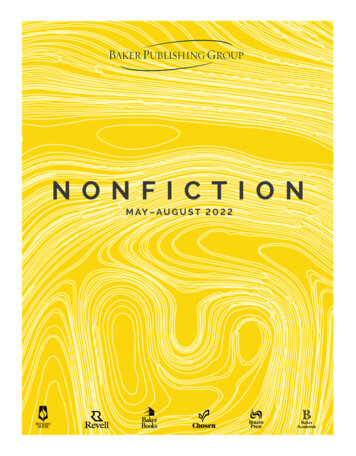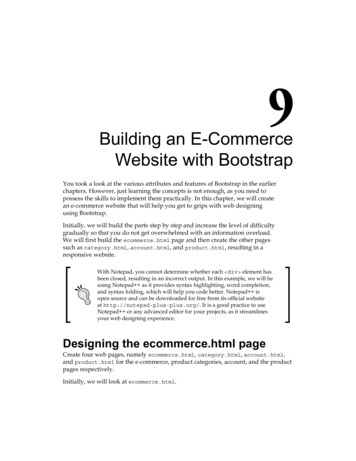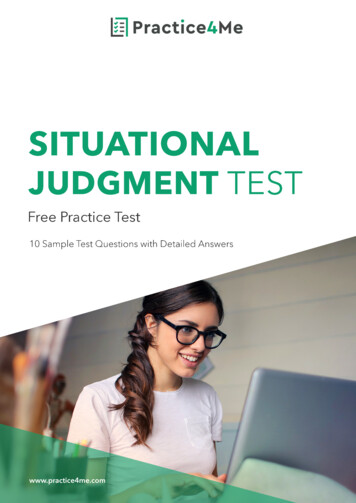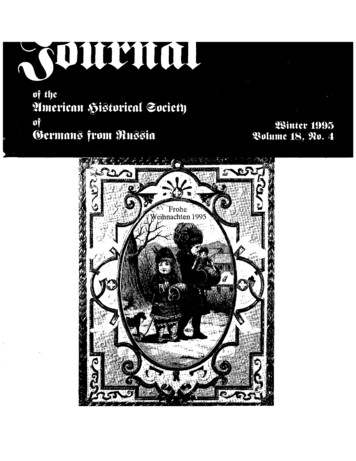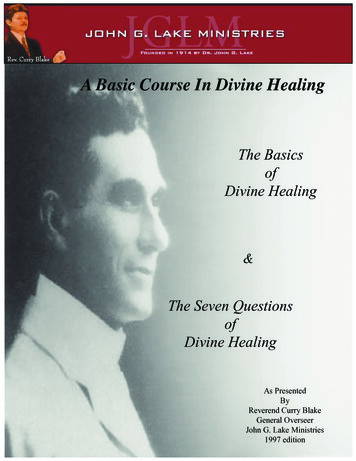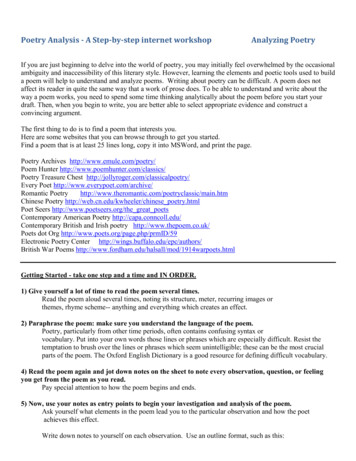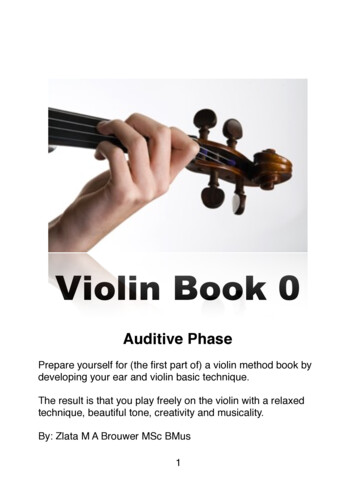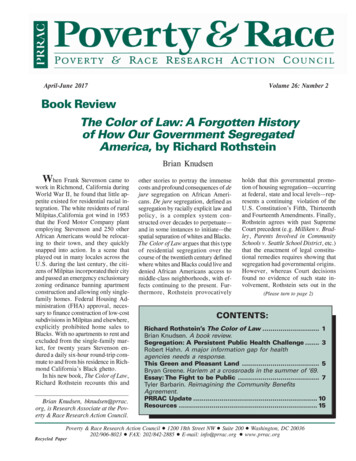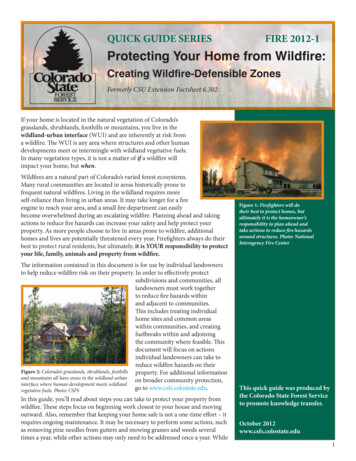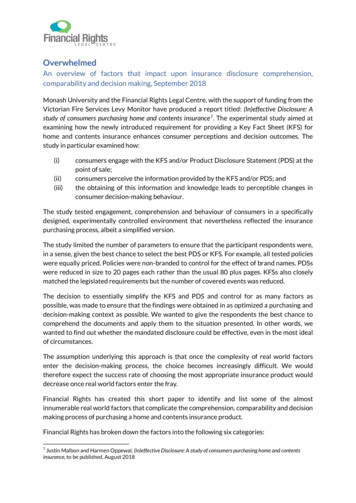
Transcription
OverwhelmedAn overview of factors that impact upon insurance disclosure comprehension,comparability and decision making, September 2018Monash University and the Financial Rights Legal Centre, with the support of funding from theVictorian Fire Services Levy Monitor have produced a report titled: (In)effective Disclosure: Astudy of consumers purchasing home and contents insurance 1. The experimental study aimed atexamining how the newly introduced requirement for providing a Key Fact Sheet (KFS) forhome and contents insurance enhances consumer perceptions and decision outcomes. Thestudy in particular examined how:(i)(ii)(iii)consumers engage with the KFS and/or Product Disclosure Statement (PDS) at thepoint of sale;consumers perceive the information provided by the KFS and/or PDS; andthe obtaining of this information and knowledge leads to perceptible changes inconsumer decision-making behaviour.The study tested engagement, comprehension and behaviour of consumers in a specificallydesigned, experimentally controlled environment that nevertheless reflected the insurancepurchasing process, albeit a simplified version.The study limited the number of parameters to ensure that the participant respondents were,in a sense, given the best chance to select the best PDS or KFS. For example, all tested policieswere equally priced. Policies were non-branded to control for the effect of brand names. PDSswere reduced in size to 20 pages each rather than the usual 80 plus pages. KFSs also closelymatched the legislated requirements but the number of covered events was reduced.The decision to essentially simplify the KFS and PDS and control for as many factors aspossible, was made to ensure that the findings were obtained in as optimized a purchasing anddecision-making context as possible. We wanted to give the respondents the best chance tocomprehend the documents and apply them to the situation presented. In other words, wewanted to find out whether the mandated disclosure could be effective, even in the most idealof circumstances.The assumption underlying this approach is that once the complexity of real world factorsenter the decision-making process, the choice becomes increasingly difficult. We wouldtherefore expect the success rate of choosing the most appropriate insurance product woulddecrease once real world factors enter the fray.Financial Rights has created this short paper to identify and list some of the almostinnumerable real world factors that complicate the comprehension, comparability and decisionmaking process of purchasing a home and contents insurance product.Financial Rights has broken down the factors into the following six categories:1Justin Malbon and Harmen Oppewal, (In)effective Disclosure: A study of consumers purchasing home and contentsinsurance, to be published, August 2018
1.2.3.4.5.6.market factorswebsite design and form factorsdocument design and formcover detailpolicy wordingindividual circumstances and behavioural factorsThe sheer number of factors listed below demonstrates the reality of the difficulties faced byconsumers when it comes to comparing and comprehending insurance policies let alonemaking the right decision. It also is a reality check on the faith governments have placed ondisclosure to assist consumers to make better decisions when purchasing insurance.As will be seen from the list, consumers are faced with huge differences in price, an array ofinsurers, a large number of products, difficulties in finding PDSs and KFSs in the first place,varying approaches to presenting disclosure information to consumers and significantvariability in definitions, terms and coverage. This is in addition to the almost infinitedifferences that individual circumstances and behavioural factors play in the process of makinga purchase decision.Put simply, making a decision to purchase insurance appropriate to one’s circumstances inAustralia is overwhelming.1. Market factorsThe following is a list of general market factors that Financial Rights see as key considerationsconsumers take into account when making a choice to purchase an insurance product - apartfrom coverage. Coverage is discussed separately in a later section.PricePrice is a central consideration for most consumers of insurance. And no wonder since pricevaries significantly from insurer to insurer. A recent survey by the NSW Emergency ServicesLevy Insurance Monitor found that there was an average difference of up to 1,100 for basichome and contents policies when comparing quotes for identical properties across 11 differentNSW suburbs. 2Brand loyaltyRecent research 3 found that 53% of Australian respondents chose to take out their mostrecent policy with a supplier that they had used previously. 86% of Australian consumerswould only consider between one to three insurers when selecting their next policy; while 76%said they liked and trusted their current provider.2NSW Emergency Services Levy Insurance Monitor, Home insurance in same suburb more than twice the pricedepending on insurer, 21 March insurer “The difference between the cheapest and most expensive quote in onesuburb, Medlow Bath, was almost 1700 – with one insurer quoting a price more than 2.5 times higher thananother.”3Target, Myth vs Reality, The Expectation Gap in the ANZ Insurance Industry, uploads/2016/10/myth vs Reality-whitepaper ANZ.pdf2
Advertising and brand recognitionClosely related to brand loyalty is behaviour driven by advertising and brand recognition ingeneral. Insurance is both a grudge purchase and a set and forget product with many peoplespending very little time thinking about their insurance needs. Insurance companies with largeadvertising budgets therefore advertise in a ubiquitous fashion, largely in an attempt toovercome this engagement gap and be at the top of mind when someone does come to makinga choice. According to Neilsen, insurance advertising made up 6% of digital advertising, 10% ofmetropolitan television, and 5% of the metro radio markets. 4 Competitive pressure may alsobe a factor, with a number of significant fines handed out in recent times to insurers formisleading consumers. 5The number of insurance brandsThe number of insurance brands is considerable. CHOICE’s most recent survey identified 29consumer facing insurance brands 6 active in the Australian home and contents market 7 toreview but other comparison sites list as many as 23 additional insurers bringing the totalnumber to 52. 8The number of insurance products availableCHOICE reviewed 53 products, 9 Canstar compared 92 products, 10 with many insurers offeringvarying levels of coverage referring to premium, standard, classic, elite or other money-going-exclusive-ad-spend-trends-reportAAMI paid a 43,200 fine for statements could lead consumers to have the impression than AAMI would alwaysrepair or rebuild homes when a claim was submitted. anceadvertising/ RAA paid 43,200 for misleading car advertising regarding a life time replacement ar-insurance-advertising/ and CommInsure was fined 300,000 overmisleading life insurance advertising -life-insuranceadvertising/6The number of underwriters is smaller than this, with many having multiple brands, but consumers are nottypically aware of this fact. Table 1 details 28 brands with 13 underwriters in total.7CHOICE, Home and contents insurance reviews, 22 March sinsurance AAMI, Allianz, ANZ, Apia, Bank of Melbourne, Bank SA, Budget Direct, CGU, Coles, CommBank, Dodo,GIO, ING, NRMA, QBE, RAA, RAC, RACQ, RACT, RACV, SGIC, SGIO, St George, Suncorp, TIO, Virgin Money,Westpac, Woolworths, Youi.8CanStar lists an additional 23 insurers available in NSW/ACT at sinsurance/?profile Building and Contents&state code NSW %26 ACT&age Below 50 years&prod type Below %24550k including Australian Seniors Insurance, Australia Post, BankWest, CGU, OziCare, Peoples ChoicestCredit Union, Real Insurance, 1 for Women, 1 Cover, AON, Aussie, Bendigo, Bupa, Catholic Church Insurance, Citi,CUA, HBF, HSBC, Hume Bank, Bank of Queensland, IMB Bank, National Australia Bank, Guild Insurance9CHOICE, Home and contents insurance reviews, 22 March sinsurance10CanStar lists an additional 23 insurers available in NSW/ACT at sinsurance/?profile Building and Contents&state code NSW %26 ACT&age Below 50 years&prod type Below %24550k53
Potential discountsInsurers offer a range of discounts to attract business. These can vary from special promotionsor marketing campaigns to loyalty discounts, purchasing channel discounts – online versusphone, no-claim discounts or multiple policy discounts. 11Use of comparison websitesComparison websites sometimes assist, sometimes hinder understanding and comprehension.Most people focus on price rather than cover when using a comparison website, andcomparing products can be almost impossible given the multiplicity of coverage, definitions,and exclusions: see further details below. They can also mislead since many commercialcomparison websites are owned by the same parent company as insurers, with their ownbrands offered on the site. 122. Website design and formSimply finding and accessing a PDS or KFS on an insurer’s website can be a difficult task, withmost prioritising their own imagery, branding and information over highlighting access to theactual PDS or KFS.Website designFinding and accessing a PDS or KFS can take a number of clicks through an insurer’s website.Some websites bundle the policy documents together on one page, others provide links on thepolicy’s webpage that open up a new browser tab. Some links download the PDS into adownload folder.Link designsThe links to PDSs and KFSs vary vastly. These can include simple coloured hyperlinks in large,bolded, underlined print, or very small, buttons, bars, lists or side bars. 13The placement of PDS and KFS links on website pagesSome websites highlight the PDS and/or KFS link somewhere in the middle of the page. Manyothers place the link to the PDS or KFS down the bottom of the page in fine print. Others stillrequire a google search because they are so hard to find. For example, there is no reference toKFSs on Woolworths home building and contents web page. Many web pages link directly to a11NSW Emergency Services Levy Insurance Monitor, Home insurance in same suburb more than twice the pricedepending on insurer, 21 March 2017 rer12John Rolfe was quoted in the Senate Report into the General Insurance industry: seven of the 10 car insurance brands on comparethemarket.com.au come from Auto & General Services Pty Ltd. BothCompare the Market and Auto & General are ultimately owned by Budget Holdings Limited. Three of the five homeinsurance brands on Compare the Market are also arranged by Auto & General. At rival comparison site Choosi, only twohome insurance brands are compared. One of them, Real, is owned by Choosi's parent, Greenstone Limited. Real is one of thefive car insurance brands compared by Choosi.https://www.aph.gov.au/Parliamentary nce/ /media/Committees/economics ctte/Generalinsurance/report.pdf13see Table 24
PDS or KFS .pdf. Others send the user to a separate page that bundle all the policy documentsfor the insurer together in a long list.Finding a KFSMany KFS links are visually secondary to the PDS by only appearing in fine print. Somewebsites do not even feature a link to a KFS, eg SGIC and Woolworths. 143. Document design and formOnce a consumer finds a PDS, there is an enormous variety in the appearance of PDSs and noconsistency. This is even the case with KFSs whose form is supposed to be locked in bylegislation.PDS designsPDS designs vary vastly from the order that the contents of the PDS are placed in, to thelayout, use of graphics, colour, font the list is endless. Even the shapes and sizes of PDS’s canvary making comparability difficult. Some PDSs take the standard DL (or “dimensionlengthwise” format- or a third of an A4 page) others take on the A5 standard (or half an A4),others still have an A4 format.PDS Naming conventionsVery few PDSs have the same title. They can vary in both the name of the thing or things beingcovered (such as use of the word ‘Household’, ‘Home’, ‘Home and Contents’ and ‘HomeBuilding and Contents’) or can vary the name of what the document is (for example, a ‘ProductDisclosure Statement’, a ‘Product Disclosure Statement and Policy’, ‘General Terms andConditions’, ‘Policy Wording’, and ‘Policy Booklet’). 15Additional or supplementary documentsMost insurers provide more than one document but in some cases there can be anoverwhelming number of documents. For example, AAMI 16 provides a total of nine: a PDS, twosupplementary PDSs, an update pursuant to ASIC Corporations Instrument 2016/1055, anupdate pursuant to ASIC Class Order 03/237, a Home Building Insurance Premiums, Excesses,Discounts & Claims Payments guide, and a NSW ESL reintroduction onto insurance premiums,in addition to the KFS. 17 A number of insurers provide A and B PDSs, the B simply acting as anadditional or supplementary PDS.PDS lengthsPDS document lengths range between 27 to 128 pages. 18 Suncorp produces two separatedocuments of 60 and 68 pages (plus a number of other documents), while most other insurersprovide the one combined product disclosure document. Most however provide14see Table 2. St George includes a link to the Contents KFS however this incorrectly downloads the Building KFS.SGIC has an incorrectly labelled KFS, and could only be found via a google search.15See Table 116As of May sonal.html#home-contents-insurance18see Table 15
supplementary PDS documents and other additional documentation as described above. JohnRolfe was recently quoted in the Senate General Insurance Report as stating:There are novels that are shorter than product disclosure statements. It is extraordinary. Theyrun to 30,000 words. It would take hours to read just one of them. So let's say you were goingto look at half a dozen of them before you picked an insurer. It is beyond belief that anyonewould do that. So no-one is ever really going to know the detail of their insurance product. 19Differing approaches to KFSsMost insurers keep the Building KFS and Contents KFS in separate .pdfs. However RACcombines their two KFSs into one .pdf, but still separate KFSs within the .pdf. 20 RACTcombines the two KFSs into one .pdf document with a combined KFS in that document. 21 Somelinks download the documents to your download folder (eg RACQ), most other links create anew web page.The legislative requirements for KFS design is that the boxes should “alternate between blacktype on a white background and black type on a light blue background.” 22 RAA however uses adark grey background. No two insurance companies use the same shade of blue.Use of logos on a KFSMost place their corporate logo on the KFS. Brands underwritten by Auto & General do not egVirgin, ING etc. According to Schedule 3 of the Insurance Contracts Act Regulations 1985, thelogo should be inserted.Language used in KFSsDifferent KFSs take different linguistic approaches to describe their coverage and exclusionson their KFS. Some use the form “Yes But we will not cover” 23 or “Excludes ” 24 to list onlythe exclusions. Others describe what is covered. 25 Many use personal pronouns eg, “We willcover” or “You’re not covered,” 26 others are impersonal, eg “No cover for . 27 Some KFSs referthe reader to a page in the PDS (eg RACQ) 28 but most do not.19Economics References Committee, Australia's general insurance industry: sapping consumers of the will tocompare, August 2017https://www.aph.gov.au/Parliamentary nce/ /media/Committees/economics .pdf22Regulation 4B(d)(iii)23Eg RAA, sheet24Eg e GET FILE&dDocName PRODCT057982&RevisionSelectionMethod LatestReleased&Rendition primary25Eg policy booklets/home contents kfs 0418 nsw act tas.pdf26Eg CGU, f27Eg Youi https://www.youi.com.au/globalassets/documents/kfs bui pdf/insurance/kfscontents.pdf?la en&hash C9CD063CA111290B414AE769AF2DED79066656266
4. Cover detailOnce a consumer gets to actually read the content of the documents, there is a vast array ofdifferences with respect to inclusions, exclusions, coverage etc that a consumer will need toweigh up.Excess levelsThe basic excess level – that is the contribution a policyholder is required to pay towards aclaim - can vary from insurer to insurer and can be set at maximum and minimum levels.However there are usually multiple, complex additional excesses, hidden in the fine print. Inhome and content insurance they can include: additional excesses based specifically on a risk assessed by the insurer (e.g. AAMI, GIO,Suncorp)extra cover excess, (e.g. AAMI)unoccupied excesses (e.g. AAMI, GIO),excesses for earthquake and/or tsunami claims (e.g. Allianz, ANZ, Bank of Melbourne,CGU, GIO, Suncorp, QBE, RAA, TIO),imposed excess (e.g. ANZ, QBE, TIO)personal valuables excess (e.g. APIA)accidental loss or damage’(e.g. Bank of Melbourne, QBE, RAA)domestic workers compensation (e.g. CGU, CommInsure)Voluntary excess (e.g. Coles, RAA, TIO)special excess (e.g. Coles, NRMA)cover outside your home excess (e.g. Coles, Youi)portable contents excess/portable valuables excess (e.g. CommInsure, GIO, Suncorp,QBE, Woolworths)legal liability insured event excess (e.g. CommInsure, TIO)motor burnout excess (e.g. GIO, Woolworths, Youi)injury to pet dogs and cats excess (e.g. GIO, Suncorp, RAA, Youi)contents in storage cover excess (e.g. QBE)student accommodation contents excess (e.g. QBE)cycle cover excess (e.g. QBE)additional carbon fibre excess (e.g. QBE)fixtures and lighting excess (e.g. RAA)non-removable endorsed excess (e.g. RAA)food spoilage excess (e.g. Woolworths, Youi)malicious acts and theft by tenants excess (e.g. Woolworths)rent default and legal expenses excess (e.g. Woolworths)business Item excess (e.g. Youi)landlord’s furnishing excess (e.g. Youi)lock and keys excess (e.g. Youi)temporary accommodation: emergency evacuation excess (e.g. Youi)escaping water excess (eg e.g. Youi)7
“Basic” or “standard” excesses may be highlighted upfront but these additional excesses arerarely if ever highlighted. A customer must search for them and know to click on a number oflinks and know to read further documents to find out the full information and potential excessquantum. F
insurance AAMI, Allianz, ANZ, Apia, Bank of Melbourne, Bank SA, Budget Direct, CGU, Coles, CommBank, Dodo, . seven of the 10 car insurance brands on comparethemarket.com.au come from Auto & General Services Pty Ltd. Both Compare the Market and Auto & General are ultimately owned by Budget Holdings Limited. Three of the five home

